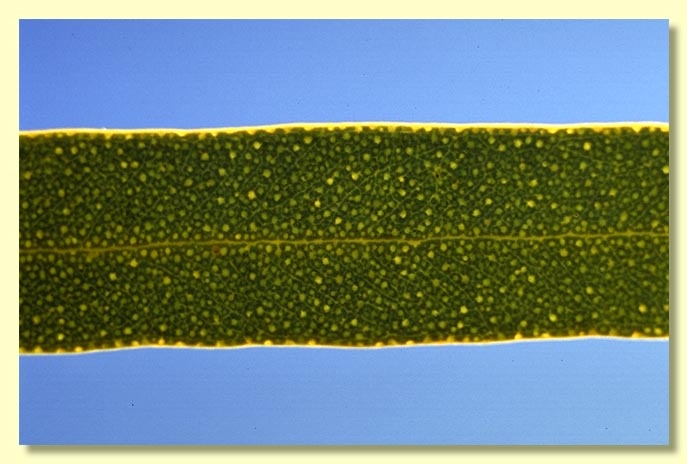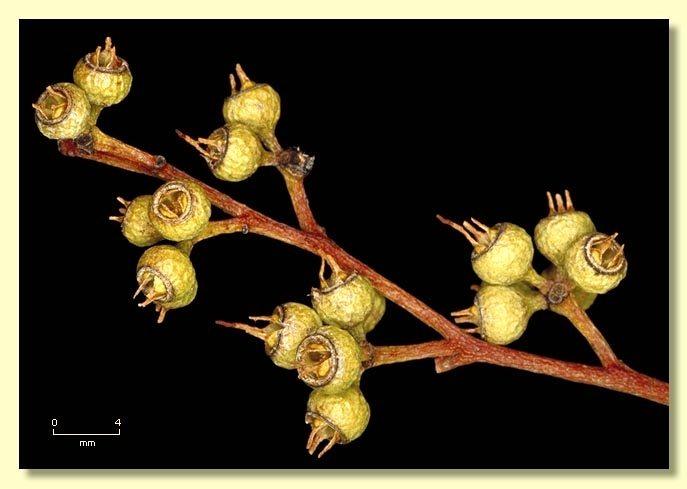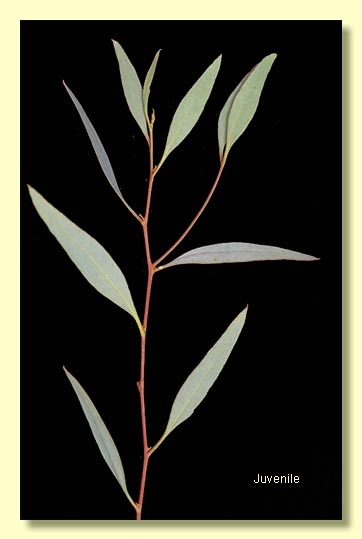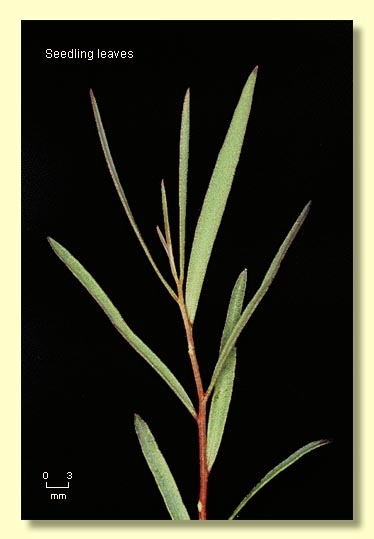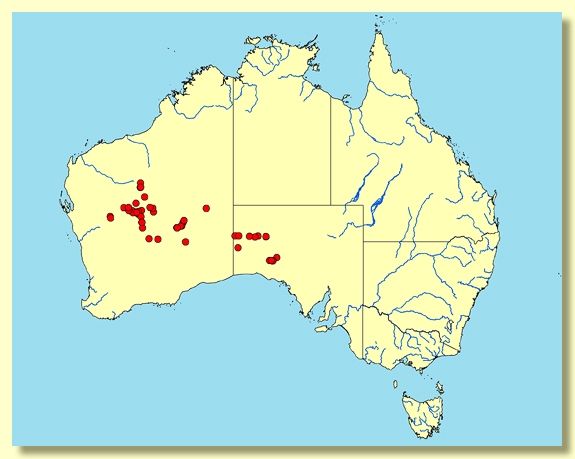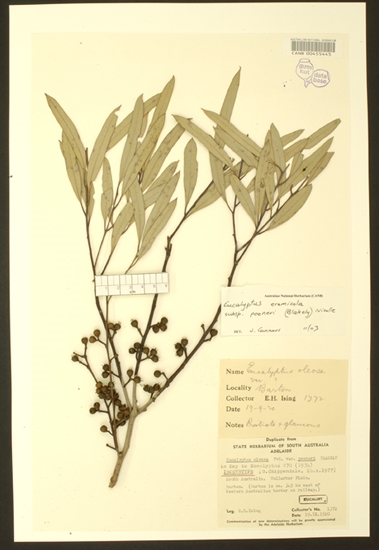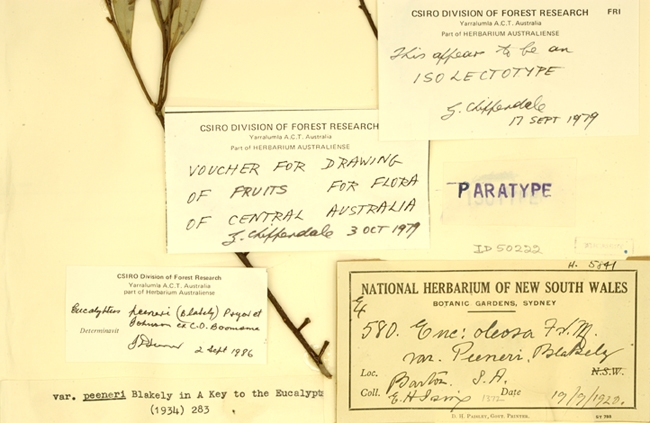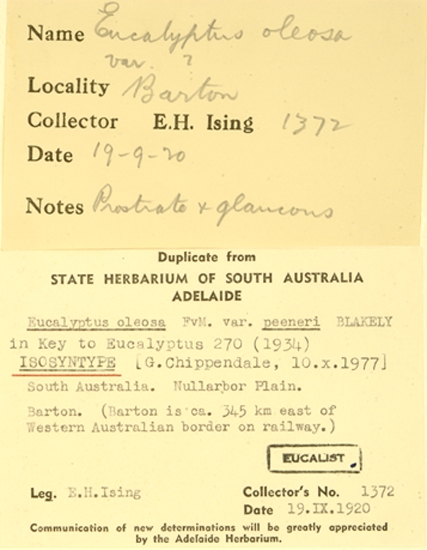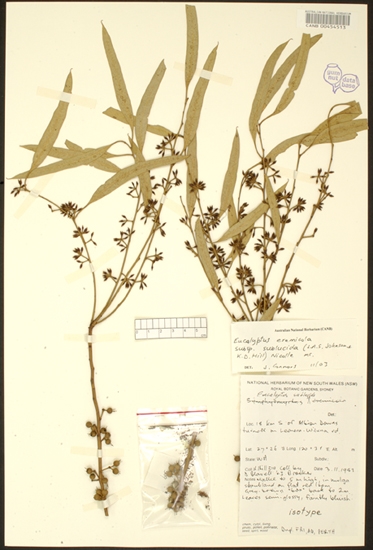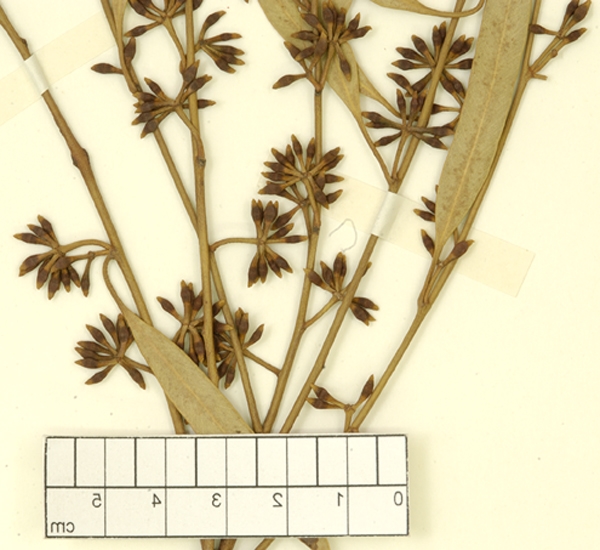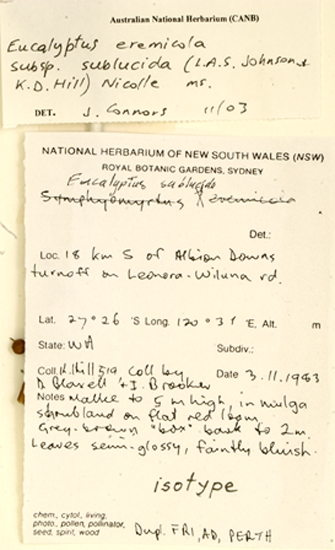Eucalyptus | Symphyomyrtus | Bisectae | Destitutae | Subulatae | Oleaginae
Euclid - Online edition
Eucalyptus eremicola subsp. peeneri
Eucalyptus oleosa var. peeneri Blakely, Key Eucalypts 270 (1934); Eucalyptus peeneri (Blakely) L.D.Pryor & L.A.S.Johnson ex Boomsma, J. Adelaide Bot. Gard. 1: 368 (1979). T: South Australia: Barton, 19 Sept. 1920, E.H.Ising 1372; lecto: NSW; isolecto: AD, CANB, G, K, PERTH, US (fide Boomsma 1979).
Bark usually rough on the lower half of the stems, fibrous on larger stems, flaky to ribbony and loosely held on smaller stems, grey; smooth bark grey to brown over white.
Branchlets lacking oil glands in the pith.
Juvenile growth (coppice or field seedlings to 50 cm): stems round in cross-section; juvenile leaves alternate and shortly petiolate, elliptical to narrowly lanceolate, 3.5–7 cm long, 0.8–1.4 cm wide, dull blue-grey.
Adult leaves alternate, petiole 0.5–1.2 cm long; blade narrowly lanceolate, 5–10 cm long, 0.6–1.3 cm wide, base tapering to petiole, concolorous, dull, blue-grey to grey-green, maturing to semi-glossy blue-green on larger mallees, side-veins acute, moderate to densely reticulate, intramarginal vein parallel to and just within margin, oil glands numerous and mostly intersectional.
Inflorescence axillary unbranched, peduncles 0.5–1 cm long, buds 9, 11 to ?15 per umbel, rarely 7, pedicellate, pedicels 0.2–0.3 cm long. Mature buds ovoid to fusiform (0.6–0.9 cm long, 0.2–0.4 cm wide), scar present, operculum conical to horn-shaped (0.3–0.5 cm long), stamens irregularly flexed, sometimes with the outer stamens erect and the inner inflexed, anthers adnate to weakly versatile, basifixed, globoid, dehiscing by lateral pores, style long, stigma tapered, locules 3 or 4, the placentae each with 4 vertical ovule rows. Flowers white.
Fruit pedicellate (pedicels 0.1–0.3 cm long), truncate-globose, 0.35–0.6 cm long, 0.4–0.6 cm wide, disc descending, valves 3 or 4, valve tips strongly exserted due to fragile style remnants.
Seeds light brown to grey, 1–2 mm long, ovoid or flattened-ovoid, occasionally with shallow longitudinal furrows on otherwise smooth dorsal surface, hilum ventral.
Cultivated seedlings (measured at node 10): cotyledons Y-shaped (bisected); stems appearing rounded to square in cross-section; leaves opposite, sessile and linear for the first 4 to 6 nodes then alternate, sessile and linear to narrowly lanceolate further up the stem, 2.8–6.5 cm long, 0.2–1.3 cm wide, dull blue-grey to grey-green. Seedlings sometimes with a bushy appearance due to many branches.
Flowering has been recorded in January, June and September.
Eucalyptus eremicola is a mallee species of the Great Victoria Desert of South Australia and Western Australia, extending north-west into the Little Sandy Desert and stretching in the west as far as the Sandstone and Leonora districts of the Goldfields of Western Australia. The bark is normally rough on the lower part of the stems. It has small buds with conical opercula and small fruit with the exserted style remnants usually persistent.
Eucalyptus eremicola belongs in Eucalyptus subgenus Symphyomyrtus section Bisectae subsection Destitutae because buds have two opercula, cotyledons are Y-shaped and branchlets lack oil glands in the pith. Within this subsection E. eremicola is part of a large taxonomic series Subulatae further characterised by globoid basifixed anthers, grey smooth seeds with shallow longitudinal furrows, and fruit with persistent exserted style remnants. Series Subulatae is divided principally into four subseries based on the juvenile leaves, one with spiral, crowded seedling phyllotaxis (subseries Spirales), another with decussate and decurrent seedling leaves (subseries Decurrentes), another with decussate non-decurrent seedling leaves (subseries Decussatae), and a fourth to which E. eremicola belongs with disjunct, petiolate seedling leaves (subseries Oleaginae).
The other members of the subseries Oleaginae are E. kochii, E. longissima and E. ultima. Within the subseries, E. kochii and E. longissima differ by having rough bark over most of the stem. E. longissima differs further by normally being a much larger plant. E. ultima is mostly smooth-barked (sometimes with rough bark for ca 0.5 m) and has very narrow linear seedling leaves.
Within its area of occurrence, E. eremicola should only be confused with E. socialis. E. socialis has bigger buds and fruit, the buds normally with a long beaked operculum.
There are two subspecies:
E. eremicola subsp. eremicola
Common in the red sands of the Great Victoria Desert. It is distinguished from subsp. peeneri by its narrow, very glossy green adult leaves.
E. eremicola subsp. peeneri
A mallee from the Great Victoria Desert of South Australia and Western Australia, extending west to the Meekathara region of Western Australia. It is often of sprawling habit with stems usually rough on the lower half. The adult leaves are usually dull, blue-green to blue-grey, but can mature to semi-glossy blue-green, particularly in the western populations where it grows slightly taller than it does in the Great Victoria Desert. This western form was formerly described as E. sublucida.
Intergrades between both subspecies are common in parts of the Great Victoria Desert.
Eucalyptus eremicola: Greek eremi-, desert and Latin cola, dweller.
subsp. peeneri: an Aboriginal name for the mallee.




